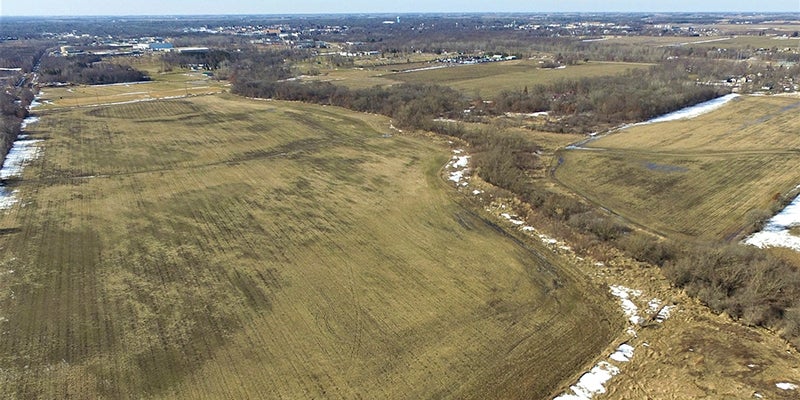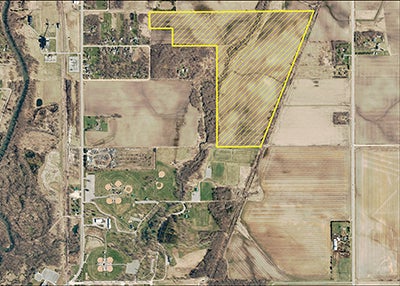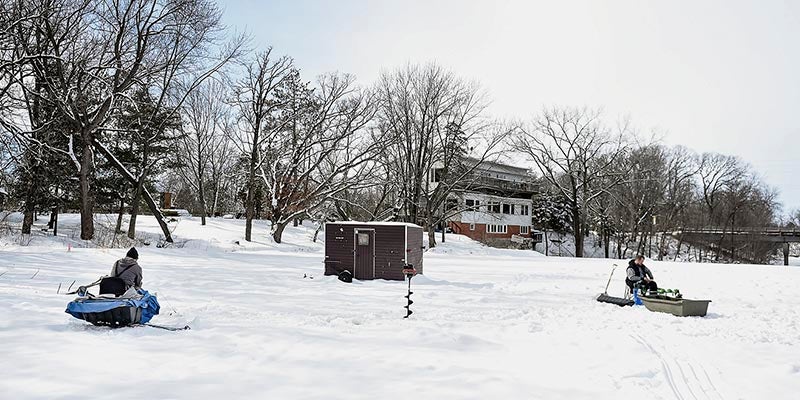Cropland to be restored to support future trout stream
Published 7:01 am Saturday, March 14, 2020

- Much of the cropland shown in this photo is part of the Persingers’ enrollment of 100 acres into permanent conservation through the MN CREP program. Photo provided
Just upstream from Austin’s Todd Park, 100 acres of cropland will be restored permanently this year to native prairie and wetlands, supporting a creek targeted by the state for trout stocking in spring.
Steve and Diane Persinger on Thursday finalized agreements with Mower Soil & Water Conservation District for enrolling their 100-acre parcel – an area about the size of 76 football fields – into the federal-state MN CREP program. The Lansing Township parcel, which will remain private property, is on both sides of Wolf Creek, just upstream from where it flows into Todd Park, the largest park in Austin.
To date, Mower County now has nine MN CREP signups totaling about 460 acres of marginal cropland going into permanent restoration for prairie and wetlands.

Yellow marks the boundaries of the Persingers’ 100 acres of cropland being enrolled in MN CREP for permanent conservation into native prairie and wetlands just north of Todd Park. Photo provided
About 444 acres of that land is in the Cedar River Watershed.
Steve Persinger, an outdoors enthusiast, looked into MN CREP because it seemed like a great opportunity to enhance the wildlife habitat on their property.
“We’re excited to see the deer, wild turkeys, pheasants and other wildlife that will be drawn even more into this area once it’s restored,” he said. “It also feels good to support Wolf Creek’s future trout fishery.”
Permanently restoring the Persingers’ land will improve water quality and wildlife habitat through conservation easements that keep the land under private ownership, said James Fett, a Mower SWCD watershed technician who oversees MN CREP in Mower County. The work later this year will include constructing multiple wetland areas that hold water either seasonally or year-round.
“The Persingers have been great to work with, and they are making a significant contribution to local conservation that will last forever while helping to protect the cold water and aquatic habitat of Wolf Creek for rainbow trout,” Fett said.
This MN CREP project will add a large amount of conservation land to the Wolf Creek watershed that already has a good amount of prairie, woods and wetlands, including acres converted to conservation through other state and federal programs, according to Fett. He’s also working to finalize a MN CREP signup for permanently restoring another 104 acres of cropland in the Wolf watershed upstream from the Persinger site.
In 2017 and 2018, Fett, who also works for the Cedar River Watershed District, collected water-temperature data at an unshaded part of Wolf Creek in Todd Park and determined the creek stayed cold enough to host trout. He asked the DNR in 2019 to consider stocking trout in Wolf Creek and the DNR agreed. It will be Mower County’s only stream stocked by the DNR for trout.
MN CREP, a voluntary program focused on marginal cropland that is flood-prone or erosive, was created in 2017 to protect and restore up to 60,000 acres of marginal cropland across 54 southern and western Minnesota counties, including Mower, by using vegetative buffer strips, wetland restoration and drinking water wellhead protection. Landowners accepted into MN CREP enroll in the USDA’s Conservation Reserve Program (CRP) for 14 to 15 years. At the same time, the land is put into a permanent conservation easement through the state’s Reinvest In Minnesota (RIM).
Mower SWCD works on MN CREP enrollments with the USDA’s Farm Service Agency (FSA) and Natural Resources Conservation Service (NRCS) along with the Minnesota Board of Water & Soil Resources (BWSR).
MN CREP pays landowners $7,000 to $8,000 per acre and covers all costs for restoring the land.
Typically, MN CREP restorations involve restoring hydrology through tile breaks, tile blocks, scrapes, embankment construction and daylighting tiles, among other practices. The site is seeded with a highly diverse mixture of native grasses and forbs beneficial to wildlife and pollinator habitat. That also prevents erosion and filters surface and ground water.
In designing MN CREP projects, engineers take careful detail to ensure that landowners upstream and downstream of the restoration site have no negative effects to their drainage.
Wolf Creek, a Cedar River tributary that begins northeast of Brownsdale, is planned to get 600 rainbow trout from the Minnesota Department of Natural Resources’ fisheries division in Waterville. The DNR will stock trout on two dates this spring in the nearly 150-acre Todd Park to start a “put-and-take” fishery with a larger size of trout for anglers to catch and keep.
Todd Park has more than 8,800 feet of public shoreline and a spring-fed pond that sends cold water into Wolf Creek.
Minnesota’s 2020 trout season will run from April 18 to Sept. 15. A catch-and-release season will then run from Sept. 16 to Oct. 15, and again from Jan. 1, 2021, to the April 2021 opener.
Trout anglers need a Minnesota fishing license and trout stamp to possess trout from non-designated waters like Wolf Creek. Trout stamps are not required for children age 17 and younger and adults age 65 and older.
Mower County landowners interested in MN CREP should contact James Fett, Mower SWCD, at 507-434-2603, ext. 5, or by email at james.fett@mowerswcd.org.





